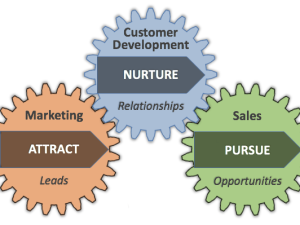
Driving Down the Cost of Marketing in Turbulent Times
The current health crisis has technology executives scrambling. The predictions are dire. The length of the downturn is likely to be protracted. Revenue will be curtailed. Investment capital will dry up. At this point, it’s all about survival.
I’d like to put a more positive spin on the situation with practical advice for reducing the marketing spend in a way that will help, not hurt. Bringing marketing to a screeching halt is dangerous. It sends the wrong signal to current and future customers and limits your ability to recover as we transition to a post-crisis economy.
Most tech companies already have an established work from home capability. So assuming your employees can operate safely, it’s important for the business to have an interim operating strategy and a game plan for the future.
Customer Retention and Revenue Recovery
While critically important to economize, it’s equally important to protect the health of the business. After employee health and safety, two primary concerns for any business are customer retention and revenue recovery.
Customer Retention is about focusing on the present. What can you do right now to maintain customer loyalty and minimize churn in your customer base? Marketing can play a big role in achieving this objective.
Revenue Recovery is about the future. What can you do right now to be ready the moment the outbreak is contained, and America goes back to work? Having a revenue recovery game plan is a smart way to be prepared for future growth.
Justifying an Investment in Marketing
If it seems counterintuitive to consider spending marketing dollars during this time, here’s a helpful way to look at any marketing investment, particularly during a downturn. First, understand your Customer Lifetime Value (LTV) and Customer Acquisition Cost (CAC). Then focus your investments on growing LTV for current customers and minimizing CAC for new customers. This will ensure every dollar spent drives value back into the company.
An Example of Maximizing LTV: A tech company that sells a SaaS solution for software development and testing has an excellent work from home capability. They are reaching out to their current customers to educate them on the most effective WFH deployment of their solution. They are also providing an incentive for customers to acquire and broadly deploy their solution across a virtual organization. This will help to retain customers and maximize LTV.
An Example of Minimizing CAC: An IT services company has expertise in systems design, information architecture and security. They are re-targeting to focus on financial services companies with solutions for virtualizing the workplace and reducing facilities expenses. A focused use of online webinars, LinkedIn outreach, virtual sales meetings and marketing automation, is significantly reducing the cost of new customer acquisition. Note the two-prong strategy: A pivot to optimize product-market fit and the exclusive use of digital marketing channels and content to reach new potential buyers.
Developing a Retention and Recovery Game Plan
Every business should have their own plan based on their business model and commercial offerings. If it’s guided by the goals of customer retention and revenue recovery, then effective investments in marketing and sales can be readily cost-justified.
A Checklist for Developing Your Own Retention and Recovery Game Plan:
Stay connected with current customers. Communicate through virtual meetings, website updates and company newsletters. Look for ways to help them maximize the value of your solutions. The goal is maximizing customer satisfaction, loyalty and retention.
Market in a socially responsible way. It’s not being exploitive to market solutions that actually help your customers operate more safely, efficiently and virtually during this uncertain time. Make sure your solutions truly help your customers cope with the crisis and represent a win-win for both you and them.
Re-focus for best product-market fit. Target a segment with the easiest access, greatest need and best fit for your solution. You may need to consider pivoting to a new market with an adapted version of your product, service or business model
Elevate your digital marketing game. Every aspect of digital marketing should be explored to maximize reach and minimize cost. Defer offline marketing expenses and double down on the use of digital channels. Take the time to become your own digital marketing expert.
Embrace the use of webinars. Everyone does webinars, but now’s the time to approach them as a science. Target your audience, carefully craft a message, and present valuable content buyers can use. In this environment, webinars are the most cost-efficient way to reach any audience.
Grow and engage your LinkedIn network. Build your connections, join groups, share relevant content and publish articles. Encourage employees to do the same. This is more effective and far less expensive than retaining a PR agency. Don’t aggressively sell or promote. The more you educate and inform, the more good will and brand awareness you will build.
Publish authoritative digital content. Now is a good time to catch up on creating those digital assets you’ve been thinking about. This is especially true if you’ve evolved your messaging. Create a case study to tell your story. Publish a solution brief that describes a problem, solution and business outcome. Produce a video that attracts attention and engages target buyers.
Business planning, product solutions, focused messaging and digital marketing have never been more important than they are right now. A retention and recovery game plan will help to ensure short term survival and also position you for long term success.




